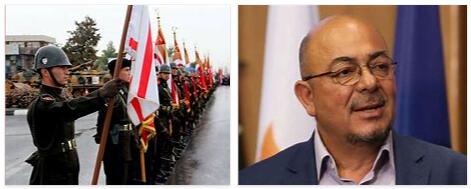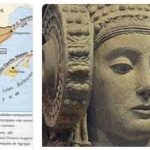Island state consisting of the island of the same name, located in the eastern Mediterranean south of Turkey and west of Syria. At the 2001 census the country’s population was 689,565 residents (780,000 at a 2005 estimate) excluding the population of the Turkish Republic of Northern Cyprus, where 230,000 people lived. The island continues to be divided into two areas, one Turkish, the other Greek (a division not recognized by the international community), which have further strengthened, even in recent decades, their different settlement and economic models: in the Turkish one they continue rural settlements are prevalent and the population considered urban does not exceed 40 % of the total; otherwise in the Greek area the percentage is much higher (69 % in 2004); the per capita GDP of the Cypriot Turks is less than 4,000 dollars per year against the over 12,000 dollars of the Greek Cypriots. The largest city in the country remains the capital, Nicosia, which in 2001 had 47,832 residents. (excluding the sector occupied by the Turks), with 200,459 in the urban agglomeration; followed by Limassol (160.733 residents) and Larnaca (71.740). Famagusta continues to represent the only main center of the Turkish Cypriot section of the island, but the data available on its demographic consistency date back to 1994 (22,200 residents).
In the early 21st century. the Greek part of the island has experienced consistent economic growth, due to the progress of the service sector and above all of tourism. On 1 May 2004 it joined the European Union in full compliance with the Maastricht parameters: it recorded a low unemployment rate (4.7 % in 2004), low inflation (3.6 % in the period 1990 – 2002), a growth rate of 4 % in 2003 and a modest public debt.
Still in the Greek section of the island, although the irrigated area is largely destined to cereal crops, viticulture and fruit growing, in 2003 the primary sector contributed only 4.1 % to the formation of GDP. Even the industrial sector, which includes few activities linked to underground resources and some small and medium-sized manufacturing industries active in the agri-food and textile sectors, does not play an important role. On the other hand, tertiary activities (especially tourism) and those related to the financial sector compete predominantly, to the extent of 76%, to the formation of the GDP. Cyprus also offers privileged tax legislation which has attracted large amounts of foreign capital to the island; however, recalled in 2000 by the OECD, the country has adopted anti-money laundering measures and is at the beginning of the new century engaged in policies aimed at eliminating the image of a tax haven (moreover, even the term offshore is no longer used and there is now talk of IBC, International Business Company).
The situation is different in the Turkish section of the island, where the economy depends mainly on agriculture (cereals, vegetables, olives, citrus fruits), public administration services and aid from the international community and, in particular, from the European Union..
HISTORY
The unresolved conflict between the central government and the self-proclaimed Turkish Republic of Cyprus del Nord continued to condition the internal politics of the country even at the beginning of the 2000s and to keep the two communities, Greek-Cypriot and Turkish-Cypriot over thirty years they lived strictly separated within the same small island. The crucial question around which the dispute revolved concerned the institutional framework on which reconciliation was to be based: while the central government was advocating a federal state project, the Turkish community, by claiming the right to self-determination, insisted on the formation of two states. nationals of equal dignity. For Cyprus 2001, please check naturegnosis.com.
The territorial extension occupied by the two communities and the compensation for the property expropriated following the Turkish occupation constituted the other unsolved elements of the dispute to which was added the proposed entry of the island into the European Community. The possibility that this would happen without the inclusion of the Turkish Cypriot area (not recognized by the international community) if on the one hand deepened the dispute, on the other it constituted a powerful stimulus to the resumption of negotiations which, dragged on throughout the 1990s, thus underwent an acceleration. The first step was the visit, in December 2001, of President G. Klerides (in office since 1993) in the Turkish Cypriot area – the first official visit since the Turkish occupation – reciprocated at the end of the same month by R. Denktaş (president, since its constitution in 1975, of the Turkish Cypriot Republic). In January 2002, there followed the resumption of direct negotiations between the parties, who declared themselves willing to confront each other without advancing any prejudicial positions. The talks, however, continued during the year, did not lead to any concrete result and the reunification project presented by the UN mediators was rejected, based on the constitution of a single federal state composed of two autonomous and equal legal entities, independent on the level of foreign policy.
While international diplomacy continued to press for an agreement, also with a view to relaunching relations between Greece and Turkey, internal resistance to dialogue was growing, considered by many to be a failure in the face of the ‘illegal’ claims of the community. Turkish Cypriot. The defeat of Klerides in the presidential elections of February 2003, won by the candidate of the Democratic Party T. Papadopoulos, was read by many as a sign of stiffening, despite the new president agreeing to resume dialogue with his counterpart. A few days after the signing of the treaty of accession to the European Union by Papadopoulos (16apr.), which in fact sanctioned the entry into Europe of Cyprus even without the Turkish Cypriot zone, Denktaş unexpectedly decreed the end of the restrictions on travel between the two parts of the island (22 apr.) and opened the ‘line verde ‘which since 1974 kept the two communities separate.
The new climate of détente favored the resumption of dialogue, but the extreme attempt to reach an agreement before May 2004, the date of Cyprus’s official entry into the European Union, so as to guarantee the inclusion of the entire island, failed to in the face of the results of the referendum, held in April of the same year, on the reunification project proposed by the UN. In fact, the majority of Greek Cypriots expressed a negative opinion (75.8 % against), compared to a majority of the consensus of Turkish Cypriots (64.9 % in favor). Despite the exclusion of the latter from the European Union, relations between the two communities intensified and direct commercial relations were resumed in August. In April 2005 the presidential elections held in the Turkish Cypriot area sanctioned the victory of MA Talat, leader of the moderate Turkish Republican Party, a supporter of a rapprochement with Europe and a reunification of the island.









